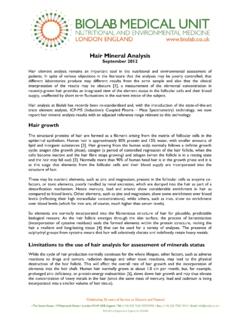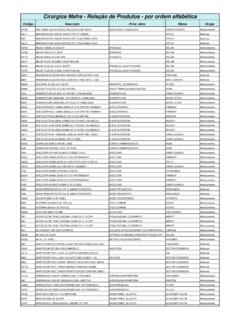Transcription of BIOLAB MEDICAL UNIT
1 Urine Kryptopyrroles Indications Measurement of urine kryptopyrroles may be indicated in subjects with central nervous system problems where the clinician suspects a deficiency of trace elements or vitamins. Pyrroluria (the syndrome that accompanies urinary excretion of kryptopyrroles) is a disorder in which haemoglobin synthesis is up-regulated as a consequence of deficiencies of these micronutrients; unusual by-products of haemoglobin intermediates subsequently appear in the urine. In this respect it is similar to the various porphyria syndromes, especially the acquired porphyrinurias. Pyrroluria is, however, especially associated with psychiatric symptoms such as schizophrenia.
2 The term Kryptopyrrole was coined by Irvine et al [1] to describe substances derived from haemoglobin precursors identified in the urine of some psychiatric patients. In the scientific literature kryptopyrroles are also referred to as the Mauve Factor [2,3]. The word kryptopyrrole is now the chemical name for 2,4-dimethyl-3-ethylpyrrole, which (somewhat confusingly) is known not to be the substance actually excreted in this condition [4]. Chemically speaking, the haemoglobin molecule is a tetra-pyrrole (containing four pyrrole groups). The substance currently believed to be excreted in pyrroluria is the monopyrrole hydroxyhaemopyrrolin-2-one, which is the hydroxy-lactam of haemopyrrole and an oxidation product derived from the haemoglobin synthetic pathway.
3 This remains to be confirmed. Hydroxyhaemopyrrolin-2-one is unstable and not commercially available for use as an assay standard [5]. Hence some laboratories still use 2,4-dimethyl-3-ethylpyrrole to standardise kryptopyrrole measurement. It is thought that the action of hydroxyhaemopyrrolin-2-one is to bind with vitamin B6 (pyridoxine) in the circulation and to deplete its body stores as the complex is cleared from the blood by the kidney. Hydroxyhaemopyrrolin-2-one excretion is also thought to promote loss of zinc and essential fatty acids in the urine, which further exacerbates the symptoms experienced by patients and increases their requirement for these nutrients [6,7,8].
4 While this problem is reported to be familial, suggesting a genetic pre-disposition to pyrroluria, these patients generally respond positively to large doses of vitamin B6 combined with zinc supplementation. Synonyms Urinary pyrroles, pyrroluria, malvaria, mauve factor [9,10]. Patient preparation No special preparation is required and the patient can continue to take nutritional supplements and medication before the collection of the sample. Specimen requirements A random, mid-stream, urine sample, with an eighth of a teaspoon of ascorbic acid added to 20 ml of urine as a preservative. A special kit and instructions can be sent from BIOLAB if required. Postal samples must reach BIOLAB within 48 hours of collection.
5 Methodology Modified Ehrlich s test with differential organic extraction. The results for this test are reported in Absorbance Units (AU), rather than as the concentration hydroxyhaemopyrrolin-2-one. Turn around time 3-4 working days. Interpretation Normally no kryptopyrrole is present in the urine and a value of less than AU is taken as a negative ( normal) result. Urinary kryptopyrrole values of greater than are taken as evidence of a significant abnormality. Values of up to AU have been recorded at BIOLAB . References 1. Irvine DG, Bayne W, Miyashita H, Majer JR (1969). Identification of kryptopyrrole in human urine and its relation to psychosis. Nature 224:811.
6 2. Irvine DG (1963). Mauve factor and 6-sulfatoxyskatole; two biochemical abnormalities associated with specific measures of psychiatric disease. Clin Chem 9:444. 3. Sohler A, Beck R, Noval JJ (1970). Mauve factor re-identified as 2,4-dimethyl-3-ethylpyrrole and its sedative effect on the CNS. Nature 228:1318. 4. Gendler PL, Duhan HA, Rapoport H (1978). Hemopyrrole and kryptopyrrole are absent from the urine of schizophrenics and normal persons. Clin Chem 24:230-233. 5. Graham DJ (1978). Quantitative determination of 3-ethyl-5-hydroxy-4,5-dimethyl-delta3-py rrolin-2-one in urine using gas-liquid chromatography. Clin Chim Acta 85(2):205-210. 6. Brodie MJ, Graham DJ, Thompson GG (1976). The porphyrinogenic effects of kryptopyrrole in the rat and the occurrence of urinary kryptopyrroles in human hereditary hepatic porphyria.
7 Clin Sci Mol Med 50:431. 7. Graham DJ, Thompson GG, Moore MR and Goldberg A (1979). The effects of selected monopyrroles on various aspects of heme biosynthesis and degradation in the rat. Arch Biochem and Biophys;197(1):132-138. 8. Pfeiffer C, Sohler A. Treatment of pyroluric schizophrenia (malvaria) with large doses of pyridoxine and a dietary supplement of zinc. J. Orthomolecular Psychiatry 3(4):292. 9. Hoffer A (1995). The discovery of Kryptopyrrole and its importance in diagnosis of biochemical imbalances in Schizophrenia and in criminal behaviour. J Orthomolecular Med 10 (1):3. 10. Hoffer A, Osmond H (1963). Malvaria: A New Psychiatric Disease. Acta Psychiat Scand 39:335-366.
8 Suggested further reading Environmental Medicine in Clinical Practice, H Anthony, S Birtwistle, K Eaton & J Maberly. British Society for Allergy, Environmental and Nutritional Medicine Publications, Southampton, UK (Tel: 01703-812124).






